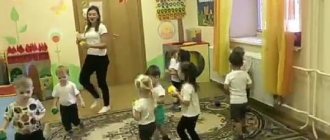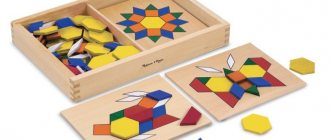9.A lot or a little?
Goal: to teach children to correlate the words “one”, “many”, “few” with the corresponding number of objects. Materials: in this game you can use small toys - cubes, sticks, balls, etc. Progress of the game: When forming the concepts of “one”, “many”, “few”, it is useful to teach children to use the appropriate gestures: “one” - show the index finger; “a lot” - a wide, circling hand gesture; “little” - a narrow, outward gesture with the hand, or fold your palms into a handful. To do this, the speech therapist constantly uses these gestures and encourages children to use them. The names of concepts should be highlighted in speech. The game is played on the carpet. Lay out the cubes in front of the children: one pile has a lot of cubes, and the other has few. Look, here are the cubes, and here are the cubes too. There are a lot of cubes here (the speech therapist shows the corresponding gesture), but there are few cubes here (the speech therapist shows the corresponding gesture). Show where there are few cubes. How do you show that there are not enough cubes? (the speech therapist encourages the children to show a gesture) Where are there a lot of blocks? How do you show that there are a lot of cubes? (the speech therapist encourages the children to show a gesture) And here is one cube. (the speech therapist shows the appropriate gesture) Take one cube at a time. Show that there is only one cube. (the speech therapist encourages the children to show a gesture) It is useful to repeat this game using different subject material.
The first session of a speech therapist with a child: where to start
Speech therapy classes are carried out for the following purposes:
- Understanding native speech, observing and comprehending everything that happens around. This is how the child learns about the world around him. The speech therapist forms general concepts, gives the basics of word formation, and teaches how to use complex phrases.
- Formation of correct pronunciation of words and development of phonemic hearing. Monitoring the clarity and expressiveness of speech.
- Teaching independent speech using different sentences.
Many people are interested in how the first speech therapist session is conducted. The first session of a speech therapist with a child, where to start:
- The child's disposition towards himself.
- Carrying out diagnostics and identifying problems.
- Introduction to the speech apparatus.
- Teaching simple speech therapy exercises and games.
- Building a work plan.
Literature to help the speech therapist: Fadeeva Yu. A., Pichugina G. A., “Speech therapy classes in the younger group”
The abstract by Fadeeva and Pichugina is intended for speech therapy classes in the younger group. It promotes the formation of speech skills in children two to three years old who have various speech problems of different etiologies. It is intended for speech therapists, speech pathologists, educators and parents.
Stages of working on a new word in speech therapy
Stages of working on a new word in speech therapy:
- Determining the relationship between a sound word and a visual, auditory and other image.
- Analysis of word composition.
- Identification of semantic features of a word.
- Introduction of a word into the semantic field.
- Consolidating the meaning of a word.
The role of the book
The book introduces the child to the world around him; develops logical and imaginative thinking, memory, imagination; expands vocabulary; teaches you how to write sentences correctly.
Through reading, a child learns to listen and concentrate.
Family reading is a way of communication between parents and children, a good method of education and a means of leisure.
Psychologists believe that children to whom their parents read books are more emotionally balanced and self-confident.
11.Big or small?
Goal: to teach children to correlate the words “big” and “small” with the size of objects. Materials: in this game you can compare any toys and objects; You can use pictures in further work. Progress of the game: When forming the concepts of “big” and “small”, it is useful to teach children to use expressive gestures: “big” - spread your arms to the sides (or simultaneously up and to the sides), “small” - bring your palms closer to each other (or bring your hands closer to each other). index and thumb towards each other). To do this, the speech therapist constantly uses these gestures and encourages children to use them. The names of concepts should be highlighted in speech. Show the children the big and small balls. Look, here's a ball, and here's a ball too. Are the balls the same? No, the balls are different. This ball is big! (the speech therapist shows the appropriate gesture), and this ball is small (the speech therapist shows the appropriate gesture). What kind of ball is this - show me. (the speech therapist encourages the children to show the gesture) That’s right, small. What is this ball? Show! (the speech therapist encourages the children to show a gesture) It is useful to repeat this game using a variety of subject material.
Fun workout
Outdoor games strengthen the muscles of the child’s body, prevent flat feet, develop coordination of movement, and contribute to the development of motor skills and speech.
Types of outdoor games:
- different types of walking (side step, walking on heels, toes);
- climbing, overcoming obstacles;
- ball games;
- balance exercises (sliding down a hill, walking on an inclined bench).
Speech imitation
A child’s reproduction of sounds, words, and phrases is called speech imitation.
It is meaningful only when speech is closely related to the child’s actions.
An adult should stimulate the child's speech with questions.
Words to be repeated must be pronounced many times; do not repeat the child’s “substitute words.” The child’s answers are accepted in any form.
The most important thing is to do everything possible so that the child does not hesitate to speak.
Speech imitation goes through several stages:
- Copying sounds that have a certain meaning.
- Repetition of amorphous words (kup-kup - swim, am-am - eat, lalya - doll).
- Repetition of simple words (baba, grandfather, drink).
- Repeating short phrases: “Give me the juice!” Where's the spoon?
Pay great attention to the use of verbs. If a child’s speech contains many action words, his level of development is quite high.
Games with speech imitation
An effective way to induce speech imitation is the use of poetic texts - finishing words and phrases by creating pauses when reading poetry.
For example:
They love... (monkeys) very much
Eat sweets... (bananas).
We are like monkeys... (look like)
And we love bananas... (too).
Gradually, the number of pauses (words skipped by adults) can be increased, thereby increasing the child’s vocabulary.
Fun games in the form of a conversation: an adult repeats a word several times, then asks the child a question, the answer to which is the highlighted word. If the question is answered correctly, the adult praises the child; if the question is answered incorrectly, he answers the question himself or offers several answer options.
Tests to determine pathologies
To quickly respond to changes in the baby’s development, you can conduct simple tests.
- By the fourth year, children can already distinguish the simplest geometric shapes. You need to ask the child to draw a circle. Even the similarity of this figure is a good result. However, if the child does not understand what is wanted from him, or his drawing does not even remotely resemble what is required, the test has not been passed.
- If a child does not show interest in new games and does not assemble a small tower from cubes, development is slow.
- By the age of three, the toddler communicates in short phrases (those who at this age already speak in long sentences are not taken into account). The minimum milestone for speech development by 3-4 years is the simplest phrases. If the child does not pronounce them, you should go to a specialist.
In what cases is it still necessary to contact a speech therapist:
- The baby does not respond to his name and does not understand simple requests.
- Shows no interest in new toys; all his game scenarios follow the pattern.
- He cannot assemble a simple turret or put a large bead on a rope.
- If by the age of three the child does not speak, there were injuries during pregnancy or early development, or there are hereditary diseases.
How to recognize disorders and when to contact a speech therapist?
The list presented above is general in nature, but if at least three points from it are not characteristic of a child’s speech behavior, this is a reason to think about it.
Here are some signs that may indicate a delay in your child's speech development:
- the pace of his speech is uneven - he sometimes speaks too quickly, sometimes he drawls out his words;
- speaks unintelligibly, only his mother understands him;
- if he speaks in phrases, then not his own, but only those he heard from adults or on TV;
- he himself has difficulty understanding what adults tell him;
- mouth constantly open, like a limp mouth;
- increased salivation not associated with teething.
If one or more signs from this list are present, it is advisable to diagnose the child’s speech development. Perhaps there really is a pathological disorder that requires special treatment, or perhaps the baby just needs speech therapy exercises. But before contacting a speech therapist, you need to show the child to a neurologist, psychiatrist and speech pathologist: they will help determine whether the delay in speech development is associated with disorders of the central nervous system or the problem is only in the pronunciation of sounds. You may also need the help of an audiologist - a specialist who identifies hearing defects. If doctors have not found any physiological reasons for the development of mental retardation, then the child will benefit from sessions with a speech therapist.
Speech therapy exercises for children 2-3 years old
In the second or third year, you can do special speech therapy exercises with your child at home. They develop movements of the lips, tongue and lower jaw. They help strengthen the muscles of the articulatory organs, due to which the appearance of sounds occurs faster. All exercises are performed in front of a mirror.
You can do the following tasks at home:
- bursting of the bubble: the cheeks are inflated as much as possible. Press your palm first on one cheek and then on the other;
- wide smile: lips are drawn out, then you need to smile widely, showing your teeth;
- show your tongue: you need to quickly stick out your tongue and then remove it.
Speech therapy songs for children 2-3 years old
Speech therapy songs for children 2-3 years old are aimed at automating sounds and clarity of speech. The lyrics and notes of the songs interest children and create a joyful and favorable mood for them. The baby sings along with pleasure, and the activity takes on a cheerful and unobtrusive atmosphere. To conduct classes at home, just download online collections of songs from the Internet.
Innovative speech therapy technologies: syncwine
How to develop speech up to 3 years. Expert advice
To form a speech, you should adhere to the following recommendations from experts:
- Play is very important for proper speech development. With its help, the baby learns about the world around him;
- must be read daily;
- you need to listen to the baby very carefully;
- It’s worth explaining your thoughts to the baby, reasoning with him, talking through plans for the future;
- the child needs to be asked questions that will encourage him to think;
- You need to discuss with your child how he spent his day in kindergarten;
- It’s worth practicing using images;
- The baby must always be supported, even if he doesn’t quite succeed.
Speech therapy chants for children 2-3 years old
Speech therapy for children aged 2-3 years is one of the main methods of working with children who have speech problems. During the work, exercises are used that were developed by Novikova-Ivantsova. Children more easily perceive phrases spoken in rhyme. Music has a beneficial effect on the psychological state of the baby. Together, this increases the effectiveness of the exercises.
The work is based on the ontogonistic principle. For those children whose vowel pronunciation is impaired, singing forms the correct acoustic image. The classes work on the ability to control the pitch of the voice. Children develop proper breathing when speaking.
Important! When selecting speech material for singing, it is necessary to take into account the age of the baby.
An example of speech therapy chants for 2-3 years:
- ku-ku-ku - the rooster crowed ku-ka-re-ku;
- gu-gu-gu - geese are wandering in the meadow.




